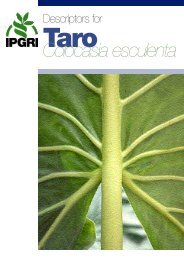Download PDF (6215 kb) - Bioversity International
Download PDF (6215 kb) - Bioversity International
Download PDF (6215 kb) - Bioversity International
Create successful ePaper yourself
Turn your PDF publications into a flip-book with our unique Google optimized e-Paper software.
EUROPEAN CENTRAL FORAGES DATABASES 35<br />
Table 2. Number of accessions per species<br />
Poa species No. of accessions Poa species No. of accessions<br />
alpina L. 9 fibrifera 1<br />
altaica Trin. 1 iberica 1<br />
ampla Merr. 2 lanuginosa 1<br />
angustifolia L. 9 ligularis 6<br />
annua L. 4 nemoralis L. 35<br />
arctica R. Br. 1 palustris L. 22<br />
asperiflora 1 pamirica 1<br />
badensis Haenke 3 pannonica 1<br />
binata Nees. 6 pratensis L. 2376<br />
bulbosa L. 68 remota Forselles 5<br />
caesia Smith 2 Poa sp. 26<br />
caespitosa Spreng. 2 subcaerulea 1<br />
chaixii Vill. 6 supina Schrad. 1<br />
compressa L. 22 trivialis L. 23<br />
Table 3. Poa Database: overview of accessions by status of sample (H. Knüpffer and E.<br />
Willner)<br />
Advanced Primitive Semi-natural<br />
cultivars, bree- cultivars, (ecotypes) or wild Unknown, other<br />
Genebank der's lines (5, 4) landraces (3) material (1, 2) (empty, 6, 7)<br />
BELCLOGRVP 2 27<br />
CHERAC 60<br />
CZEZUBRI 155 61 3<br />
DEUBGRC 59 1 11 64<br />
DEUGAT 8 36<br />
DEUIPKM 220 9 258<br />
GBRIGER 57 1 33 12<br />
GBRRBGK 35<br />
HUNRCA 30 22<br />
POLIHAR 61 1297 94<br />
ROMSUCEAVA 7<br />
TURARARI 7 6<br />
Total 562 1326 245 503<br />
Total for all accessions: 2636<br />
Ten species are represented by only one accession each. Twenty-six accessions that came<br />
without a species designation are designed as 'Poa sp.' For an overview of the species and<br />
their frequencies in the database, see Table 2.<br />
The accessions in the database are reported to originate from 42 different countries. More<br />
than 50% of the accessions (1409 accessions) originate from Poland, followed by 210 from<br />
former GDR, 115 from the Netherlands and 104 from Germany. Eleven countries are<br />
represented by one accession each. Only 172 accessions came without information about<br />
country of origin.<br />
Table 3 gives a survey about the status of the samples (according to FAO/IPGRI<br />
Multicrop Passport Descriptors).<br />
The 'Guide' of 1991 distinguishes three parts in forage crop databases: (1) Advanced<br />
cultivars and breeders' lines, (2) Primitive cultivars and landraces, and (3) Semi-natural<br />
(ecotypes) or wild material. The numbers given in Table 3 are the descriptor numbers<br />
according to the 'Guide'. The descriptors for these parts of the databases are mainly<br />
overlapping. Therefore, it was decided to compile only one single Poa database, from which<br />
the sub-databases can be created if necessary. Since not all contributors provided<br />
information about the status of samples, there would have been a certain part of the database<br />
which could not be classified in any of these three parts.




